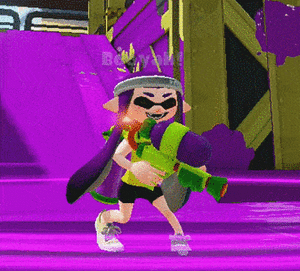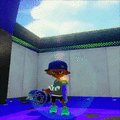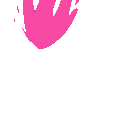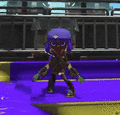Signal

Can you help us get it done?

- For the similarly named Tricolor Turf War mechanic, see Ultra Signal.
Signals are quick messages in online multiplayer battle modes in the Splatoon series. Sent only to members of the same team, they service as a means of communication and finding friendly players in danger. There are two different signals: one used to indicate joy and one used to call other players to the caller. The messages have some visual and audio effects, accompanied by the message's text appearing on-screen. These signals are not visible or audible to the opposing team, nor can they see the user make a pose.
Using
At any point during a match, a message may be sent by using ![]() ; the message depends on the direction pressed. It is possible to send the down signal at any point, but when the player has been splatted, the up signal becomes unusable in Splatoon and changes to "Ouch.." in Splatoon 2. This is perhaps to stop players from calling their friends to certain demise. When the player is in a life ring after being splatted in Salmon Run, the up signal changes to "Help!", to indicate that they need to be revived by a teammate.
; the message depends on the direction pressed. It is possible to send the down signal at any point, but when the player has been splatted, the up signal becomes unusable in Splatoon and changes to "Ouch.." in Splatoon 2. This is perhaps to stop players from calling their friends to certain demise. When the player is in a life ring after being splatted in Salmon Run, the up signal changes to "Help!", to indicate that they need to be revived by a teammate.
In Splatoon 2, the Booyah Bomb special weapon added in version 4.1.0 utilizes the down signal as part of its gameplay. When activated, the user and their teammates are prompted to press the down signal as fast as possible. Doing so speeds up the charging of the attack and slightly fills up the special gauge of any ally that contributed.
In Octo Valley, Octo Canyon, and Return of the Mammalians, ![]() serves to switch between sub weapons instead.
serves to switch between sub weapons instead.
Appearance

When the player sends a signal, some rings come out from below their character and the text corresponding to the message appears on-screen above the messenger. If the player is standing still, they also strike a pose which can be canceled at any time by moving. For other players on the same team, the message's text sticks to the borders of the screen when they are not facing the signaling player and appears through walls, regardless of distance. Teammates that are sending a signal have the message displayed on top of their large button on the map screen.
Audio-wise, teammates can hear a player announce their signal out loud if they are in range. In Splatoon, the ![]() also plays signal voice clips from teammates, regardless of distance. As for the calling player themselves, their own character's signal shout only plays very quietly.
also plays signal voice clips from teammates, regardless of distance. As for the calling player themselves, their own character's signal shout only plays very quietly.
It should be noted that if a player uses a signal after being splatted, or shortly before, their signal's text appears on the bottom of the screen, even when the camera shifts to the splatter. This can cause some players to think that the opponent used a signal and they were able to see it, while this is not the case.
List of signals
There are two signals, activated by pressing either Up or Down on . The exact text sent by the signals differs between region.
| Language | ||||
|---|---|---|---|---|
| Alive | Splatted during Regular or Anarchy Battle | Splatted during Salmon Run | ||
| NA English | C'mon! (Splatoon) This way! (Splatoon 2 & 3) |
Ouch... | Help! | Booyah! |
| E/A English | To me! (Splatoon) This way! (Splatoon 2 & 3) |
Ouch... | Help! | Nice! (Splatoon) Booyah! (Splatoon 2 & 3) |
| Japanese | C'mon! ("カモン", Kamon) |
They got me! ("やられた", Yarareta) |
Help! ("ヘルプ!", Herupu) |
Nice! ("ナイス", Naisu) |
| NA Spanish | Come! ("¡Vengan!") |
They got me! ("¡Me dieron!") (Splatoon 2) Ouch! ("¡Ay!") (Splatoon 3) |
Help! ("¡Ayuda!") |
Great! ("¡Genial!") |
| E/A Spanish | Here! ("¡Aquí!") |
They got me! ("¡Me han dado!") |
Help! ("¡Ayuda!") |
Great! ("¡Genial!") |
| NA French | This way! ("Par ici!") |
Ouch... ("Aïe...") |
Help! ("À l'aide !") |
Excellent! ("Excellent!") |
| E/A French | This way! ("Par ici !") |
Ouch... ("Aïe...") |
Help! ("À l'aide !") |
Nice! ("Joli !") |
| German | To me! ("Zu mir!") |
Done for! ("Erledigt!") |
Help! ("Hilfe!") |
Cool! ("Cool!") |
| Italian | With me! ("Con me!") |
Ow ow... ("Ohi ohi...") |
Heeelp! ("Aiutooo!") |
Great! ("Grande!") |
| Dutch | Go here! ("Hierheen!") |
Ouch! ("Auwie!") (Splatoon 2) Ow... ("Auw...") (Splatoon 3) |
Help! ("Help!") |
Cool! ("Cool!") |
| Russian | This way! ("Сюда!", Syuda) |
Misfortune! ("Непруха!", Nepruha) |
SOS! ("SOS!") |
Woo hoo! ("Йо-хо!", Yo-kho) |
| Chinese (Simplified) | Convene! ("召集!", Zhàojí) (Prior to Splatoon 3 1.2.0) Come here! ("来这里!", Lái zhèlǐ) |
Dead! ("阵亡!", Zhènwáng) |
Help! ("求救!", Qiújiù) |
Commend! ("称赞!", Chēngzàn) (Prior to Splatoon 3 1.2.0) Nice! ("赞!", Zàn) |
| Chinese (Traditional) | Convene! ("召集!", Zhàojí) (Prior to Splatoon 3 1.2.0) Come here! ("來這裡!", Lái zhèlǐ) |
Dead! ("陣亡!", Zhènwáng) |
Help! ("求救!", Qiújiù) |
Commend! ("稱讚!", Chēngzàn) (Prior to Splatoon 3 1.2.0) Nice! ("讚!", Zàn) |
| Korean | This way! ("이쪽이야!", Ijjogiya) |
They got me! ("당했어!", Danghaesseo) |
Help me! ("도와줘!", Dowajwo) |
Nice! ("나이스!", Naiseu) |
At its core, the intent is for the up signal to alert teammates that the player needs help or wants teammates to Super Jump, and for the down signal to serve as a general happiness shout. The signal's text appears on the screen of each person on the player's team, but while the signal is the same, the on-screen text corresponds to the respective player's region. For instance, if a North American player in Splatoon presses Down on , they see "Booyah!" on their screen, but a European teammate sees "Nice!". Because of this, some confusion may arise if players misinterpret the up signal, which could be seen as either encouragement or a cry for help, due to the ambiguity of the term "C'mon". In response to players' criticisms of this ambiguity, the up signal was changed to be "This Way!" in Splatoon 2.[1]
Signals can be used while in Recon mode, but only in Splatoon 3. They cannot be used in the test range, Battle Dojo, Inkopolis Plaza, Inkopolis Square, Octo Valley, Octo Canyon, the Deepsea Metro, the Order Sector, or the Spire of Order. In Alterna, the up signal can only be used with Smallfry selected, to call Smallfry back to the player once thrown.
Gallery

Reason: Needs more gifs of weapons using signals
Splatoon
-
An Inkling using a signal in the middle of a battle
-
An Inkling with a Slosher using the up signal
-
North American up and down signals
-
European/Oceanian up and down signals
-
Japanese up and down signals
-
An Inkling with a Carbon Roller using both European/Oceanian signals
-
An Inkling with a Heavy Splatling Remix using both European/Oceanian signals
-
A LINE sticker from the Splatoon: Inkling Injection pack, of an Inkling shouting "Booyah!"
Splatoon 2
-
Signals being used in Clam Blitz
-
An Inkling with a .96 Gal using the down signal in Salmon Run
-
An Inkling with Splat Dualies using the up signal
-
A sticker from the Splatoon 2: Animated Antics pack, of an Inkling using the up signal
-
Another sticker, using the down signal
Splatoon 3
-
An Octoling using the down signal
-
An Octoling using a Tacticooler
-
Shooter (link to file)
-
Roller (link to file)
-
Charger (link to file)
-
Slosher (link to file)
-
Splatling (link to file)
-
Dualie (link to file)
-
Brella (link to file)
-
Blaster (link to file)
-
Brush (link to file)
-
Stringer (link to file)
-
Splatana (link to file)
Trivia
- If a player uses the up signal while wielding a slosher, instead of pumping their weapon up and down in the air like with most other weapons, they swing the slosher in a circle to their side a few times while saying it.
- Octolings have different sound effects when they try to communicate.
- A pre-release image of Splat Zones teaser showed an early up signal labeled "Let's go!".
- In Splatoon 2, signals are left behind when the player begins respawning, and signals are allowed to play out at the end of a match.
- Return of the Mammalians is the first story mode to use signals.
- While the player cannot use signals in Octo Canyon, members of the Parallel Canon use the "Ouch..." signal after being splatted. They notably use distorted versions of voice clips from Splatoon 2 that are otherwise not present in Splatoon 3.
- Additionally, the Booyah Bomb in Side Order charges quickly on its own, without having to use any signals.
Names in other languages
| Language | Name | Meaning |
|---|---|---|
| シグナル shigunaru |
Signal | |
| Signaal | Signal | |
| Zeichen | Sign | |
| Señal | Signal | |
| 信号 xìnhào (Mandarin) |
Signal | |
| 信號 xìnhào (Mandarin) |
Signal | |
| 시그널 sigeuneol |
Signal |















